|
|
Norfolk

|
|
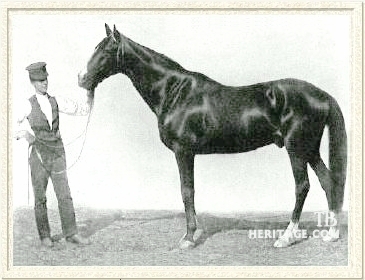 |
|
|
Norfolk was a product of that most successful Lexington - Glencoe cross that dominated American racing in the second half of the nineteenth century. He was bred at Richard Alexander's Woodburn Farm at Spring Station, Kentucky, where his sire, Lexington, held court and foaled in 1861, as Federal and Confederate troops were criss-crossing Kentucky, engaging in skirmishes and disrupting travel.
His dam, Novice (1853), by Glenoce, was one of the first horses bred by Alexander, from Chloe Anderson, by Rudolph. Novice had been a successful race mare, the fastest, Alexander said, he had ever trained up to the time of Norfolk's birth, and she won at Lexington, Kentucky, but was retired to the stud at age four.
|
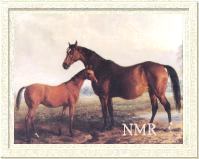
Novice produced Norfolk, was second dam of the great Volante, and seen as third dam on both sides of the pedigree of Americus. |
|
Novice produced three colts in succession; the one born the year prior to Norfolk, the gelded bay Norton, was the first product of her cross with Lexington, and as a three year old Alexander told visitors Norton was one of the "very fastest horses he had ever seen race in Europe or America." Novice went on to produce seven more foals by Lexington, and youngsters by Australian, Planet, Glen Athol, Asteroid, and King Alfonso. In all, Novice became the dam of nineteen live foals, failing to conceive only twice during her long years of production. Her 1877 Lexington daughter, The Nun, produced Clara D (1875, by Glenelg), who was dam of the in-bred -- and as it turned out, highly influential -- Americus, by Emperor of Norfolk (by Norfolk). Another daughter of Novice, Sister Anne (1876, by Glenelg) produced the great race horse Volante, winner of the American Derby and the Saratoga Cup for Lucky Baldwin of Rancho Santa Anita, California.
|
Norfolk was a golden bay colt with three white feet and a broad, odd-shaped blaze on his face. He was a lovely mover, with great range and freedom of motion. He had clean legs and excellent angles, perhaps a bit too long in the cannon bone. He was evenly balanced, and somewhat resembled Lexington, although he had heavier muscling in his forearms and gaskins, and was bulkier in the haunches, conformation that promised -- and delivered -- speed. At age two, Alexander had a price of $800 set on him, with his paddock mate, another Lexington son, Asteroid priced at $1000, because he was the grandson of the great producer Blue Bonnet, dam of two good runners in Lightning and Thunder.
His first race was in St. Louis, in May of 1864, when he was age three; the war was raging far from St. Louis, where business men had put up a great deal of money for the scheduled races. Norfolk "carried his white marked face as if conscious of superiority, and the white feet were moved with the ease of the winged heels of Mercury," cantering during his morning exercise. He was favored by the thousands gathered to watch the races that day, and he did not disappoint. Despite running away with his rider before the start, he won in a big gallop, putting away a top field of youngsters. Theodore Winters from Yolo County, California, and Washoe County, Nevada, was at the races, and soon after he purchased Norfolk, whose price Alexander had raised to $15,001.00, one dollar more than Alexander had paid for Lexington. Some stories say Norfolk was purchased specifically to beat the reigning champion of the west coast, Lodi, who had whipped Winters' Margaretta, an expensive Kentucky-bred mare by Lexington, in a race earlier that year in San Jose, California. Lodi was co-owned by Judge C.H. Bryan, a racing, business and political rival of Winters'.
Norfolk had already been engaged to run in some important races in the east, and Winters opted to fulfill those engagements before shipping Norfolk to California. Norfolk was shipped north, to win the (Jersey) Derby Sweepstakes held by the Passaic County Agricultural Association in Paterson, New Jersey, on June 7; this was the first derby ever run in the U.S., and in it he beat another Lexington son, Kentucky, who had been the top runner in the east, until his defeat -- the only defeat of his career -- by Norfolk in this race, in which Kentucky ran fourth. In the race, the bay Tipperary ran second, the chestnut Eagle, third, with the remaining eight horses behind Kentucky. Norfolk had been slated to run in the Travers and Sequel (Kenner) Stakes at Saratoga, but his entries were thrown out by the Saratoga racing managers because one of Norfolk's connections, James Eoff, had spread a rumor that Norfolk was slated to be shipped to California before the Derby, leading some big betting men to place their money on the losing Kentucky (it was rumored that Winters made as much as $100,000 in the betting pools on Norfolk's Derby). It was Kentucky that went on to win both the Travers and the Sequel.
With Norfolk banned from running in the biggest upcoming races, Winters wasted no time arranging a berth for him on the Henry Chauncey,which sailed July 5th for the isthmus of Panama. Norfolk was accompanied by his trainer, George Rice, and his groom - exercise boy Dick Havey. At Panama he was transferred to the Golden City,and he reached San Francisco "without so much as a pimple on his leg." While he rested at San Francisco early in the spring of 1865, hundreds of people went there to catch a look at the first really top class runner to arrive in the state. He was then transferred to Winters' Rancho del Arroyo in Yolo County, ten miles from where the California State Farm, now University of California, Davis, would be established some forty years later.
While Norfolk was in transit, in California racing circles and among the betting public, rumors had been flying regarding a match between Lodi and Norfolk. A race to be run in 2 mile heats was set up, to be held at the windy and cold site of Ocean House Race Course in San Francisco on May 23, with a $5,000 stake provided by San Francisco boosters. Despite Winters' attempts at secrecy, word of Norfolk's promising trials leaked out, and he was favored in the betting pools before the race. Lodi's connections brought an east-coast jockey named Gilpatrick out to ride Lodi; Norfolk was ridden by Dick Havey, who had never ridden in a race beyond a mile. Norfolk won the first heat by a head, and easily bested Lodi in the next two heats, the first being declared a draw (see Lodi). Some Lodi supporters claimed the horse, which had a preferences for hard, dry surfaces, had been hampered by the wind and fog-soaked footing of the turf, and that, combined with the huge popularity of the first match, led to another two encounters between the two horses.
The State Agricultural Society arranged to have the opening day race card at Sacramento's Union Park Course in September (during the State Fair), include a $1,000 2 mile heats race, intended as a race for Lodi and Norfolk, and a second race, 3 mile heats, to be run for $2,000 six days later. Initially a promising horse named Pilot was rumored to be an entry as well, and another horse, named Unknown (formerly Heenan), by Belmont, was entered, but then withdrawn. The betting pools favored Norfolk, and they were right. Havey was again on Norfolk, and California jockey Wilbur Pierce was on Lodi; as in the first race, Lodi spotted Norfolk 10 pounds. In the first race, held on Monday, the first heat was close, and fast, with Lodi pushing Norfolk to establish a new California record in the first mile of 1:45. Norfolk, pulling his rider, surged ahead by three lengths, with Havey battling him to preserve a steady pace, and Lodi gamely came up to within a neck, but in the final stretch, Havey gave Norfolk some rein, and he opened up a one to two length lead, wining the heat in 3:37-3/5, a new record in the state. Norolk won the second heat by three lengths in 1:46 and 3:38-1/4.
Lodi, who had been troubled by a quarter-crack entering the race, was now indisbutably lame, and six days rest and treatment did little to alleviate the problem. Nonetheless, with a crowd of 12,000 anticipating the race, he met Norfolk again in the 3 mile heats race on Saturday. In the first heat Norfolk established a three mile (heats) record that was unbroken for many years -- 5:27-1/2 and 5:29-1/2, the only race in which both heats were run under 5:30. Lodi, despite his foot, was never less than two lengths away, and in the stretch forced Norfolk to extend by getting his nose close to Norfolk's saddle. In the second heat the game Lodi was beaten by less than a length, although his quarter crack had opened up and he ran "spurting blood at every stride." This was the triumphant end of Norfolk's career on the turf, and the following spring he began covering mares at Rancho del Arroyo.
Norfolk in the Stud
Norfolk immediately established primacy as the leading sire in California, and held that position through the 1880s, after which the offspring of an increasing number of other imported stallions with pedigree and class began to appear on the track. California had a paucity of thoroughbred mares, and not that many thoroughbred stallions when Norfolk began his stud career, so to say his book was full is to say he got whatever "bred" mares in the state could be sent to him, given their owners' finances. He got plenty of winners in California, and his daughters, as producers, spread his blood throughout the state. He stood at Rancho del Arroyo until Winters purchased and established a new farm just south of Sacramento, in 1880-81, conveniently located near rail lines that could take his runners east. Winters' California bloodstock were all transferred to the new Rancho del Rio, near the banks of the Sacramento River; in Yolo County Winters left behind a flourishing town on part of his former acreage, which was named for him. Winters also owned a large spread in Washoe, Nevada, named Rancho del Sierras, where his elaborate Victorian home was erected, and animals were regularly transferred between Nevada and the California ranches.
There wasn't an important breeder in the state that didn't have a daughter or two of Norfolk's in his stud: the list is a virtual "who's who" of the sporting scene in the last quarter of nineteenth century California: Leland Stanford, A. Maillard, James Ben Ali Haggin, Nathan Coombs, George Hearst, F. Du Puyster, George Treat, William Boots, L.U. Shippee, Henry Williamson, R. Porter Ashe, Col. Harry Thornton, Simeon Reed, William MacDonough (later owner of Ormonde), and many others had Norfolk daughters in their broodmare bands, and they were the initial foundation mares upon which Haggin built his enormous Rancho del Paso stud. The Breeder and Sportsman noted in 1885:
"Not only is he the sire of nearly all the winners at the race meetings held on the Coast since his advent here, but his blood and quality has descended to the second and third generation--it asserts itself whenever and wherever the starter's flag is lowered.
At the last meeting of the Blood-Horse Association [Bay District Track, San Francisco] nineteen different horses won races, and of these thirteen were closely related to Norfolk. Billow, who won the California Stakes, is by Longfield, her dam Medea, by Norfolk. Estil, winner of the Winters' Stakes, is a son of Norfolk. Sabrina is a son of Norfolk. Jim Douglas, by Wildidle, dam Yolone, by Norfolk. Beaconsfield, by Hock-Hocking, dam Eileen Allannah by Norfolk. King of Norfolk, by Norfolk. Arthur H., by Hock-Hocking, dam, Maid of the Mist by Norfolk. Ed Corrigan, by Joe Hooker, dam Countess Zeika, by Norfolk. Ned Cook, by Flood, son of Norfolk. Alta, by Norfolk. Ingleside, by Norfolk. Billy Ayers, by Shannon, dam Lady Clare, by Norfolk. Glendair, by Norfolk. The other two, Philip S. and Billy the Kid, are by Leinster, dam Lilly Simpson, by Newry, full brother to Norfolk.
The remaining four, Nellie Peyton, Duke of Monday, Belle of the Lake, and Dottie Dimple are not descended from the son of Lexington and Novice, although all are akin through Lexington, whose blood is found close to the surface in every one of the nineteen. The 'Norfolk Cross' will continue to bring winners to the post for many generations to come."
His highest class youngsters were the result of his cross with Winters' exceptional broodmare, Marian (see Yo Tambien and Emperor of Norfolk for more information on Marian). From their pairing in successive years between 1876 and 1887, Marian produced ten live foals, all but the first (who was sold to Oregon before Winters realized how potent the cross was) stakes winners. Of these, EMPEROR OF NORFOLK, purchased as a yearling by Lucky Baldwin of Rancho Santa Anita in Southern California, THE CZAR, who died enroute to engagements on the east coast at the age of three, and the undefeated EL RIO REY were the best, of the highest class. The others were dominant west coast runners, some of which also won in Chicago and elsewhere. Marian, incidentally, had a full sister, Roxaline, who was sold to Erastus Burgess, owner of Riverside Stud near Woodstock, Ontario; to the cover of his stallion, the New York-bred Princeton (by Oakland), she, like Marian, produced outstanding runners in Canada and the U.S., including Princess (1880, winner of 38 races; Brait (1882), winner of 33 races; Willie W. (1881), winner of 17, including the 1885 Queen's Plate, and Fred B. Roxaline also produced Easter (1879) winner of 28 races, including the 1882 Ontario Derby, and Rocquefort, winner of 8 races. Together, these two daughters of Maggie Mitchell (by imported Yorkshire and out of a Glencoe mare) bred winners of almost 260 races.
|
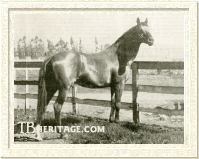
Emperor of Norfolk
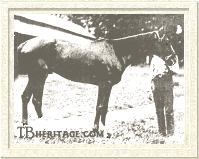
El Rio Rey
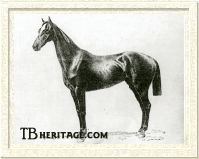
Duchess of Norfolk
|
|
EMPEROR OF NORFOLK (1885, from Marian) was the top juvenile in the U.S., winning 12 of his 18 starts in Chicago, Kansas City, and New York. At age three, he won nine of his 11 races, in Tennessee, Chicago, and New York, including the two most important races for three year olds at that time: Washington Park's American Derby over 1-1/4 miles (beating Belmont Stakes winner Sir Dixon) and the Brooklyn Derby. He retired to Baldwin's Rancho Santa Anita, where he became an influential sire in California. It is through the daughters of his son, the speedy Rey del Carreres (Americus in England) that such horses as Nasrullah, Royal Charger and Tudor minstrel emerged.
THE CZAR (1886, from Marian) won all the top races for two and three-year-olds in California. He was shipped east to compete, but died of strangles en-route. EL RIO REY (1887, from Marian) was an outstanding juvenile, winning all of his seven starts, including the Brewers' Stallion Stakes at St. Louis, the Kenwood Stakes and Hyde Park Stakes at Washington Park (Chicago), the Great Eclipse Stakes, the White Plains Handicap, and the Dunmow Stakes in New York. He developed lung trouble and was retired to Winters' stud, where he was a successful sire of California winners.
DUCHESS OF NORFOLK (1879, from Marian) was an excellent winner for Winters. As a juvenile she won the Connors Stakes at Oakland, two sweepstakes in Sacramento, a sweepstakes in San Jose, and the Ladies Stakes and Finnigan Stakes in San Francisco, the latter a walk-over. At age three, Winters shipped her to Chicago, hitching her a ride in one of James Ben Ali Haggin's (owner of the vast Rancho del Paso north of Sacramento, and later of Elmendorf Farm in Kentucky) private Pullman horse rail cars. In the east she won an allowance race at Chicago, and the Handicap Sweepstakes at Sheepshead Bay, New York. Back home in California, she went on to win the biggest races on the Pacific Coast--the Winters Stakes, the Pacific Cup, and the Spirit of Times Stakes, and was retired to stud because there were no more horses in the state for her to beat.
|
|
Among the colts of Norfolk's first crop was Flood, from Hennie Farrow, who also also the dam of the great race mare Mollie McCarty. Flood was a successful racehorse in California for Winters, and in the stud got a bay filly for Leland Stanford named Guenn (1883, from Glendew by Imported Glengarry (a son of Thormanby)), foaled at Stanford's Palo Alto Stock Farm. Glendew's dam, Glenrose, was by Lexington, making Guenn 3 x 3 to Lexington, a type of in-breeding not uncommon in a state saturated with Lexington blood. Guenn did not run at age two, but showed great promise in trials, and was sold to Californian Porter Ashe, owner of the great racemare Geraldine.
|
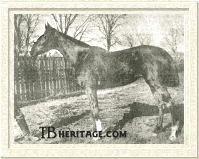
Guenn, Norfolk's grandaughter through son Flood
|
|
Racing for Ashe's Maltese Villa Stable, Guenn ran successfully at age three in California and in the east, starting 17 times and winning the Pocahontas Stakes at Saratoga and a handicap at Sheepshead Bay, beating War Eagle and other good horses. She ended her season with a grand triple victory at San Francisco's Bay District track: The Fame Stakes, a two mile "dash" in which she beat her one opponent by ten lengths in the good time of 3:38-3/4; two days later she ran in and won both the first and last races on the card, the Vestal Stakes for three-year-old fillies at 1-1/4 miles, carrying 115 pounds, and then the all-age Del Rio Stakes over 2-1/8 miles, winning in a canter and beating the American Derby and Saratoga Cup winner Volante, the good Molly McCarthy's Last, and two others.
|
Sold to James Ben Ali Haggin, she was shipped east to run at age four, winning her only start, the Brooklyn Cup over 1-1/2 miles, beating high class stakes winners such as Elkwood and Fenelon easily by three lengths. She fell, injujring a hip, soon after the race, and crippled, was sent back to Rancho del Paso in California to become part of Haggin's broodmare band.
She was a poor broodmare, in that she lost several foals young and was often barren, a state Haggin's farm manager attributed to her fragility and difficulty in getting up and down, due to her hip. In 1892 she produced her third foal, Emma C., by one of Haggin's stallions, imported Darebin. Emma C., bought by James Keene of Kentucky, in an east coast sale of Haggin yearlings, was a big, growthy youngster, like her huge sire, and did not race at age two. At age three she won twice at two miles, carrying 124 pounds, and came near to running close to the record time of 3:27-1/2 over two miles, making that distance at 3:29. Keene developed a dislike of her, based principally on her coarse looks, and gave her to his trainer, William Lakeland (the trainer of Domino). As Keene's trainer, Lakeland received two complimentary seasons to Domino after he was retired to stud in 1896, and Emma C., over Keene's objections (he was building a court of English imported mares for Domino), was bred to Domino in 1897, his second, and last season at stud. The result of this breeding was Commando, the most influential stallion in America since Lexington, despite having gotten only 27 foals. Thus, Emma C. brought back to Kentucky and to the great race horses issuing from Commando, several generations of California breeding that began with Norfolk.
Another Norfolk grandaughter, El Salado (1895, Emperor of Norfolk-Atalanta by Grinstead) produced the great weight-carrier and Metropolitan Handicap winner Jack Atkin (winner of 56 of his 156 starts, placing 32 times, and third 19). Through him, she became ancestress of the sprinting stakes-winning colt Dayjur (1987) and is also seen in the pedigree of the great American classic winner and Japanese sire, Sunday Silence.
Norfolk's own daughters, as can be seen from the The Breeder and Sportsman commentary, were successful producers of racehorses. Ichi Ban (1882), C.H. Todd (1884) and his brother, Sorrento (1886), and a great many other grandchildren through his daughters were good stakes winners in California, Chicago, St. Louis, New York, and elsewhere, some of them competing with and beating the best.
Norfolk was periodically brought out for display at various agricultural events. In 1874 he made an appearance at the State Fair grounds during the fall meeting of the California Agricultural Society, leading the parade of stallions to the background music of a brass band. Turf writer and editor Joseph Cairn Simpson, who had bred Marian in Illinois: "After the lapse of so many years we did not require to be informed of the identity of the leader. There was the matured horse and yet so like the youngster in the paddock [Simpson had seen him in Kentucky as a two year old] that we could not be mistaken. With all the increase of bulk, the volume of muscle, the rounding of the crest, the swelling of the barrel, there was the same stately carriage, the same elasticity of movement and the same defiant air. And thus, in September 1874, on the grounds of the California Agricultural Society at Sacramento we saw Norfolk for the third time."
Several years later, in 1878 or 1879, Simpson visited Rancho del Arroyo, where Norfolk, around age 17, was holding court. Winters' farm manager, A.J. Woods, regularly exercised the horse, as a hunter--of rabbits. Norfolk, carrying the 180 pound Woods and a heavy stock saddle, would go out with a brace of greyhounds at his heels. In the big flat fields along the banks of Putah Creek, the greyhounds would scare up jackrabbits, and a chase would ensue, with Norfolk and Woods "...off with a burst of speed that he could scarcely have excelled in the days of his youth." Norfolk, to Simpson's eye, "never looked better. Better than in the show condition when exhibited, for the coat was just blooming, and the daily and at times sharp exercise had absorbed a portion of the adipose tissue, and the muscles stood out fully and almost as hard as when training. The legs were without a puff and the eye as bright as of yore."
Simpson saw Norfolk again at Rancho del Rio at age 21 and reported: "There is so little change from the time when he coursed over the fields at El Arroyo, that it is sufficent to say that there may be a trifle more sway in the back, and a few more grey hairs through his coat. His eye could not be brighter, and when he was led out of the box for the artist to sketch there was the vigor of a six year old."
Norfolk was around 20 years old when he was moved to Rancho del Rio in the early '80s, although his best--Emperor of Norfolk and El Rio Rey were still to come. By 1887 he was declining in health and fertility, and Winters had limited his book to four of his own mares and two outside mares, one owned by (later Senator) George Hearst, and one the property of Col. James McNasser. He did get all six mares in foal, but it required 53 services to do it. This was his last crop; the following year he served four mares, but none caught. He died on November 15, 1890 at Rancho del Rio, which is where Winters set a zinc-covered oak slab on a large oak tree, beneath which Norfolk is presumably buried. The marker stated:
NORFOLK
Unbeaten
1861-1890
Rancho del Rio continued to operate after Norfolk's death, with Joe Hooker and El Rio Rey serving as the principal stallions; Winters had long since retired from racing, and was devoting himself to breeding "for the market," selling most of his yearlings in auctions at San Francisco. In the early '90s Winters decamped permanently for his Nevada Ranch, but continued to breed horses there for a few years, sending the youngsters to San Francisco for auction. In the 1920s part of the Rancho del Rio property became a private airfield, and was later sold to the City of Sacramento as the site of its municipal airport; the Rancho del Rio land beyond the airfield boundaries was gradually developed, and today is a mixed-development area of commerce and suburban houses.
--Patricia Erigero
|
|
|
|

